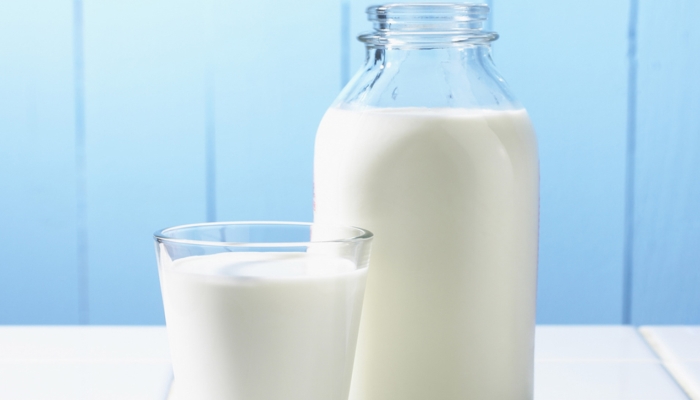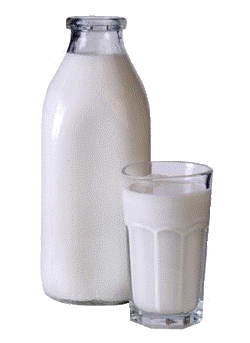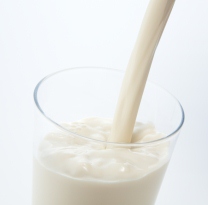
Milk is an opaque white liquid produced by the mammary glands of mammals. It provides the primary source of nutrition for young mammals before they are able to digest other types of food. The early lactation milk is known as colostrum, and carries the mother's antibodies to the baby. It can reduce the risk of many diseases in the baby. The exact components of raw milk varies by species, but it contains significant amounts of saturated fat, protein and calcium as well as vitamin C. Cow's milk has a pH ranging from 6.4 to 6.8, making it slightly acidic.
Human breast milk is the perfect food for infants, provided it comes from a healthy, well-nourished mother and the infant is full-term. Breast milk contains important antibodies, white blood cells, and nutrients. In communities where hygiene is poor, breast-fed babies have fewer infections than formula-fed babies. In the past, infants who could not be breast-fed were given cow’s milk that was partially “humanized” with the addition of water and a small amount of sugar or wheat flour. However, this was far from an ideal substitute for breast milk, being lower in iron and containing undenatured proteins that could produce allergic reactions with bleeding into the gut and, in some cases, eczema.
milk contains important antibodies, white blood cells, and nutrients. In communities where hygiene is poor, breast-fed babies have fewer infections than formula-fed babies. In the past, infants who could not be breast-fed were given cow’s milk that was partially “humanized” with the addition of water and a small amount of sugar or wheat flour. However, this was far from an ideal substitute for breast milk, being lower in iron and containing undenatured proteins that could produce allergic reactions with bleeding into the gut and, in some cases, eczema.
Lactose, the characteristic sugar of milk, is a disaccharide made of the monosaccharides glucose and galactose. Some adults can break down the lactose of large quantities of milk into galactose and glucose, but others have an inherited lactose intolerance as a result of the lactase enzyme no longer being secreted into the gut after the age of weaning. As a result, unabsorbed lactose is fermented by bacteria and produces bloating and gas. People who have little lactase in their bodies can still consume large amounts of milk if it has been allowed to go sour, if lactobacilli have split most of the lactose into lactic acid (as in yogurt), or if the lactose has been treated with commercially available lactase. People originating in northern Europe usually retain full intestinal lactase activity into adult life.
Cow’s milk is good food for human adults, but the cream (i.e., the fat) contains 52 percent saturated fatty acids as compared with only 3 percent polyunsaturated fat. This fat is either drunk with the milk or eaten in butter or cream. Because milk fat is regarded as undesirable by people who want to reduce their energy intake or cholesterol level, the dairy industry has developed low-fat cow’s milk (with 2 percent fat instead of the almost 4 percent of whole milk), very low-fat skim milk, and skim milk with extra nonfat milk solids (lactose, protein, and calcium) that give more body to the milk. Buttermilk, originally the watery residue of butter making, is now made from either low-fat or skim milk that has been inoculated with nonpathogenic bacteria.
Most commercially available milk has been pasteurized with heat to kill bovine tuberculosis organisms and other possible pathogens. The most widely used method for pasteurizing milk is the high-temperature, short-time (HTST) sterilization treatment. If products are to be stored under refrigeration, or even at room temperature, for long periods of time, they may be processed by ultrahigh temperature (UHT) pasteurization. Another method of preserving milk without refrigeration involves the removal of water to form condensed milk, which can be exposed to air for several days without deterioration. Milk, either whole or defatted, can also be dried to a powder. In some countries, such as the United States, milk is homogenized so that fat particles are broken up and evenly distributed throughout the product.
Pasteurization
Pasteurization is used to kill harmful microorganisms by heating the milk for a short time and then cooling it for storage and transportation. Pasteurized milk is still perishable and must be stored cold by both suppliers and consumers. Dairies print expiration dates on each container, after which stores will remove any unsold milk from their shelves.
A newer process, ultrapasteurization or ultra-high temperature treatment (UHT), heats the milk to a higher temperature for a shorter time. This extends its shelf life and allows the milk to be stored unrefrigerated because of the longer lasting sterilization effect but affects the taste.
Microfiltration
Microfiltration is a process that partially replaces pasteurization and produces milk with fewer microorganisms and longer shelf life without a change in the taste of the milk. In this process, cream is separated from the whey and is pasteurized in the usual way, but the whey is forced through ceramic microfilters that trap 99.9% of microorganisms in the milk (as compared to 95% killing of microorganisms in conventional pasteurization). The whey is then recombined with the pasteurized cream to reconstitute the original milk composition.
Creaming and homogenization
Upon standing for 12 to 24 hours, fresh milk has a tendency to separate into a high-fat cream layer on top of a larger, low-fat milk layer. The cream is often sold as a separate product with its own uses; today the separation of the cream from the milk is usually accomplished rapidly in centrifugal cream separators. The fat globules rise to the top of a container of milk because fat is less dense than water. The smaller the globules, the more other molecular-level forces prevent this from happening. In fact, the cream rises in cow's milk much more quickly than a simple model would predict: rather than isolated globules, the fat in the milk tends to form into clusters containing about a million globules, held together by a number of minor whey proteins. These clusters rise faster than individual globules can. The fat globules in milk from goats, sheep, and water buffalo do not form clusters so readily and are smaller to begin with; cream is very slow to separate from these milks.
cream is often sold as a separate product with its own uses; today the separation of the cream from the milk is usually accomplished rapidly in centrifugal cream separators. The fat globules rise to the top of a container of milk because fat is less dense than water. The smaller the globules, the more other molecular-level forces prevent this from happening. In fact, the cream rises in cow's milk much more quickly than a simple model would predict: rather than isolated globules, the fat in the milk tends to form into clusters containing about a million globules, held together by a number of minor whey proteins. These clusters rise faster than individual globules can. The fat globules in milk from goats, sheep, and water buffalo do not form clusters so readily and are smaller to begin with; cream is very slow to separate from these milks.
Milk is often homogenized, a treatment which prevents a cream layer from separating out of the milk. The milk is pumped at high pressures through very narrow tubes, breaking up the fat globules through turbulence and cavitation. A greater number of smaller particles possess more total surface area than a smaller number of larger ones, and the original fat globule membranes cannot completely cover them. Casein micelles are attracted to the newly exposed fat surfaces; nearly one-third of the micelles in the milk end up participating in this new membrane structure. The casein weighs down the globules and interferes with the clustering that accelerated separation. The exposed fat globules are briefly vulnerable to certain enzymes present in milk, which could break down the fats and produce rancid flavors. To prevent this, the enzymes are inactivated by pasteurizing the milk immediately before or during homogenization.
Homogenized milk tastes blander but feels creamier in the mouth than unhomogenized; it is whiter and more resistant to developing off flavors. Creamline, or cream-top, milk is unhomogenized; it may or may not have been pasteurized. Milk which has undergone high-pressure homogenization, sometimes labeled as "ultra-homogenized," has a longer shelf life than milk which has undergone ordinary homogenization at lower pressures. Homogenized milk may be more digestible than unhomogenized milk.
Nutrition and health
The composition of milk differs widely between species. Factors such as the type of protein; the proportion of protein, fat, and sugar; the levels of various vitamins and minerals; and the size of the butterfat globules and the strength of the curd are among those than can vary. For example:
Human milk contains, on average, 1.1% protein, 4.2% fat, 7.0% lactose (a sugar), and supplies 72 kcal of energy per 100 grams.
Cow's milk contains, on average, 3.4% protein, 3.6% fat, and 4.6% lactose, 0.7% minerals and supplies 66 kcal of energy per 100 grams.
Donkey and horse milk have the lowest fat content, while the milk of seals and whales can contain more than 50% fat. High fat content is not unique to aquatic mammals, as guinea pig milk has an average fat content of 46%.
Nutritional value
Processed milk was formulated to contain differing amounts of fat during the 1950s. One cup (250 ml) of 2%-fat milk contains 285 mg of calcium, which represents 22% to 29% of the daily recommended intake (DRI) of calcium for an adult. Depending on the age, milk contains 8 grams of protein, and a number of other nutrients (either naturally or through fortification) including:
Biotin
Pantothenic acid
Iodine
Potassium
Magnesium
Selenium
Thiamine
Vitamin A
Vitamin B12
Riboflavin
Vitamins D
Vitamin K
The amount of calcium from milk that is absorbed by the human body is disputed. Calcium from dairy products has a greater bioavailability than calcium from certain vegetables, such as spinach, that contain high levels of calcium-chelating agents, but a similar or lesser bioavailability than calcium from low-oxalate vegetables such as kale, broccoli, or other vegetables in the Brassica genus. The concentration of iodine in milk is usually higher than in the plasma of the mother, but may vary with her dietary iodine intake.
Medical research
Studies show possible links between low-fat milk consumption and reduced risk of arterial hypertension, coronary heart disease, colorectal cancer and obesity. Overweight individuals who drink milk may benefit from decreased risk of insulin resistance and type 2 diabetes. One study has shown that for women desiring to have a child, those who consume full fat dairy products may actually slightly increase their fertility, while those consuming low fat dairy products may slightly reduce their fertility. Milk is a source of conjugated linoleic acid.
Milk appears to be effective at promoting muscle growth.
Lactose intolerance Lactose, the disaccharide sugar component of all milk must be cleaved in the small intestine by the enzyme lactase in order for its constituents (galactose and glucose) to be absorbed. The production of this enzyme declines significantly after weaning in all mammals. Consequently, many humans become unable to properly digest lactose as they mature. There is a great deal of variance, with some individuals reacting badly to even small amounts of lactose, some able to consume moderate quantities, and some able to consume large quantities of milk and other dairy products without problems. When an individual consumes milk without producing sufficient lactase, they may suffer diarrhea, intestinal gas, cramps and bloating, as the undigested lactose travels through the gastrointestinal tract and serves as nourishment for intestinal microflora who excrete gas, a process known as anaerobic respiration.
Lactose, the disaccharide sugar component of all milk must be cleaved in the small intestine by the enzyme lactase in order for its constituents (galactose and glucose) to be absorbed. The production of this enzyme declines significantly after weaning in all mammals. Consequently, many humans become unable to properly digest lactose as they mature. There is a great deal of variance, with some individuals reacting badly to even small amounts of lactose, some able to consume moderate quantities, and some able to consume large quantities of milk and other dairy products without problems. When an individual consumes milk without producing sufficient lactase, they may suffer diarrhea, intestinal gas, cramps and bloating, as the undigested lactose travels through the gastrointestinal tract and serves as nourishment for intestinal microflora who excrete gas, a process known as anaerobic respiration.
It is estimated that 30 to 50 million Americans are lactose intolerant, including 75 percent of Native Americans and African Americans, and 90 percent of Asian Americans. Lactose intolerance is less common among those descended from northern Europeans.
Lactose intolerance is a natural process and there is no reliable way to prevent or reverse it. Lactase is readily available in pill form, and many individuals can use it to briefly increase their tolerance for dairy products.
Ethical concerns
Vegans and some other vegetarians do not consume milk for a variety of reasons. They may object to features of dairy farming including the necessity of killing almost all the male offspring of dairy cows (either by disposal soon after birth, for veal production, or for beef), the routine separation of mother and calf soon after birth, other perceived inhumane treatment of dairy cattle, and culling of cows after their productive lives.
![]()
Disclaimer: This website is for information purposes only. By providing the information contained herein we are not diagnosing, treating, curing, mitigating, or preventing any type of disease or medical condition. Before beginning any type of natural, integrative or conventional treatment regime, it is advisible to seek the advice of a licensed healthcare professional.
Top view
Health Men
19.08.2017
What Will Happen to Your Body if
Chicken eggs possess numerous beneficial properties and can be used
+ View04.07.2017
The Best Greens To Eat
We all know that greens are important to eat and top the list when we
+ View04.07.2017
Eat Daily For Clean Arteries
The other day my dad went to see his doctor. My dad was scheduled to
+ View29.12.2016
5 Foods You Should NEVER Eat On An
Since childhood, we’ve all been told to add as many fruits and
+ ViewHealth Women
19.08.2017
What Will Happen to Your Body if
Chicken eggs possess numerous beneficial properties and can be used in
+ View04.07.2017
The Best Greens To Eat
We all know that greens are important to eat and top the list when we
+ View04.07.2017
Eat Daily For Clean Arteries
The other day my dad went to see his doctor. My dad was scheduled to
+ View29.12.2016
5 Foods You Should NEVER Eat On An
Since childhood, we’ve all been told to add as many fruits and veggies as
+ View

































